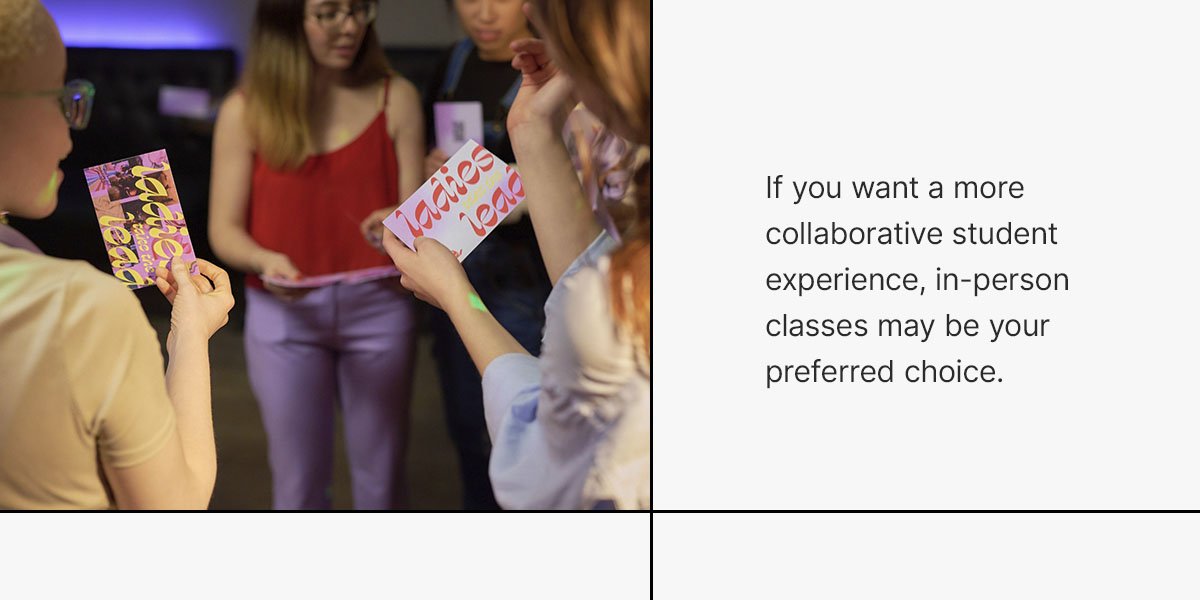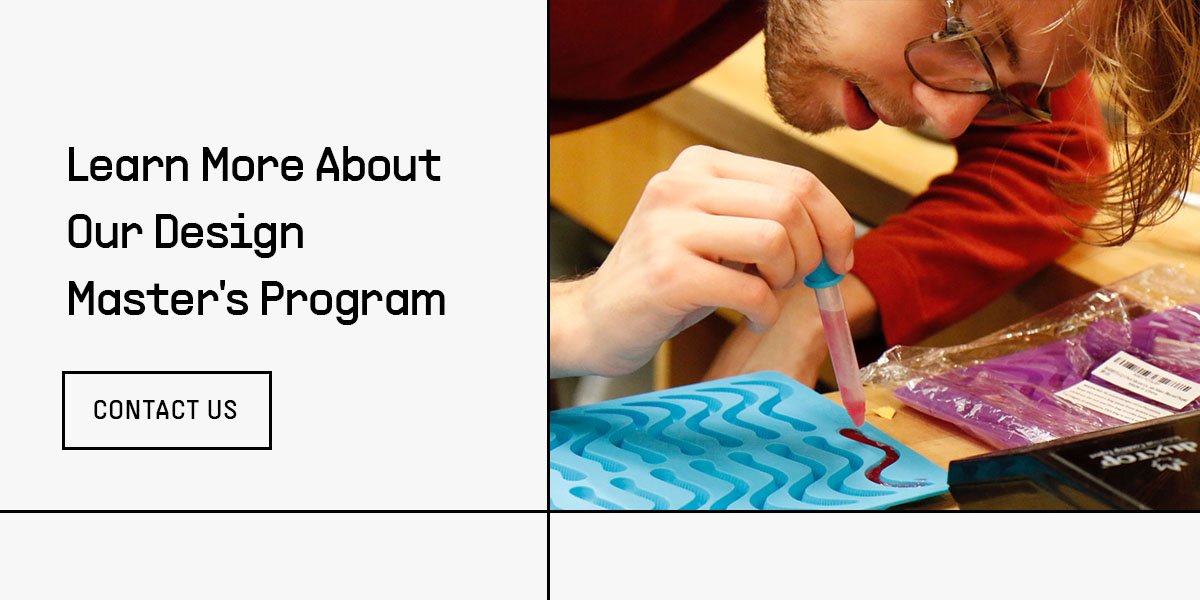6 Tips for Choosing a Design Grad School
Pursuing a master’s in design is an opportunity to learn more about the world of design, deepen your knowledge and make valuable connections that will serve you well throughout your entire career. You may be wondering where to start looking for a master's program that's right for you. If you have been considering an MFA in design, but don’t know where to start, we can help make the process easier with our six tips for choosing a design grad school.
Why Pursue a Design Graduate Degree?
Is a Master’s in design even worth it? If this question has been on your mind, know that design grad school is a valuable investment. People pursue graduate design degrees for many reasons—to challenge themselves, provide solutions to society's needs, and expand their range of career opportunities. Considering the time, money, and commitment required, it's wise to think about what you want to achieve after two years of intense study and personal development. Passion for your field and a desire to expand your career options are two great reasons for pursuing a graduate degree.
A graduate degree in design offers you exposure to skills and methodologies that evolve with every new advance in technology. You will gain competencies that make you a desirable candidate to employers who, in turn, may pay you more because of your advanced skills and higher education.
Your portfolio from design school will also provide a competitive edge. Aside from your education, employers will want to have a visual representation of who you are as a designer—what makes you unique and how your creativity, innovation and values add to their business. A design graduate degree offers an opportunity to develop and improve your portfolio, creating a memorable impression of both your skills and character.
The key to knowing how to pick a design master's program that is right for you begins with understanding your needs and career goals.
What to Consider When Choosing a Master’s Program in Design?
As every master's program offers a unique experience, the one you choose should align with your long-term goals for the future. Consider the program structure, pedagogy, and location to find the best match for you. The following tips can help you choose:
1. Write Down Your Goals
There is no replacement for writing things down on paper. Before beginning your search for a design grad school, you should clearly understand your motivation for returning to school and it always helps to visualize. Common goals for grad school include:
Specializing in a particular field
Changing careers
Making a more positive impact
Getting into a field that is more creative and entrepreneurial
Improving your chances of promotion
Increasing your earning potential
Reaching a personal goal
On a blank piece of paper, give yourself the space to write down any goals you have set for yourself. You may be surprised by what you discover! Knowing your “why” is the first step to finding the right fit for you.
2. Think About Domain Areas
A future in design means making things whether that be products, apps, services, experiences or businesses. Because design is a vast field that applies process innovation to almost everything in our world, it’s useful to think about the kinds of work and people you’d like to be engaged with when you return to the workplace.
In your future, are you interested in designing for healthcare, or designing for accessibility? Or perhaps you are interested in future technology, or mental wellbeing, or just designing for joy? Making a list of the kinds of design outputs and the fields of practice you are interested in can go a long way to helping you decide which programs to investigate
It can also be helpful to envision the kinds of people you would be interested in working with. Are you interested in people who work with a linear problem-solving process, or a looser, more lateral one? Are you interested in working with people research and strategy, or would you rather delve into prototyping and iterating? Making a list of the kinds of people you’d like to surround yourself with and the kind of network you’d like to build will help you identify what kind of program might be the best fit.
3. Browse Job Listings
The first question for a lot of people looking for grad schools is “What kind of job will I get when I graduate?” so let’s skip to the end for a moment. Because design—and product design in particular—spans many job types, it’s a great idea to see what those activities look like from the perspective of a potential employer. Looking at job postings for “product designer” or “industrial designer” or “interaction designer” or “design researcher” or “design strategist” will give you some exposure to the professional skill sets that companies are looking for as well as introduce you to the kinds of design teams that exist. For example, there are consultancies that design for separate companies or brands and there are in-house teams that design for their own organization. There are also start-ups, not-for-profits and many other places where you might find yourself after grad school. Checking out job listings is a great way to get a feel for the skills and lexicon that companies are looking for in potential candidates. Bonus: Doing this research may also pique your interest in jobs you had yet to consider or didn't even know existed. Job browsing will give you a sense of available opportunities.
While you’re looking, it can be useful to refer to the credentials of professionals in your field of interest. What did they study, and what skills have they gained over their career? If you want to work for a specific company, for example, investigate which graduate schools their employees attended.
4. Evaluate the Program Format
Be honest and realistic about how you want to live over the course of the next two years.: Do you want a flexible, part-time program that enables you to work? Do you want a program that offers more flexibility or a set curriculum? What will “student life” look like for you?
You can also choose an accelerated program or the typical two-year degree.
Knowing whether the program offers in-person classes or virtual learning formats can also be helpful l. Working adults or parents may lean toward a specific option. If you want a more collaborative student experience, in-person classes may be your preferred choice.
5. Consider Program Qualifications and Requirements
Many grad schools have standard requirements, but every school is different. The most common requirements are:
Application and fee: You must complete an online application form and pay the accompanying fee. Check with the school to ensure you have all the required documentation. Select applicants may sit for a Zoom interview.
Tuition: Learn the program cost, affordability and financial aid options.
Transcripts: These documents include an official academic record of your undergraduate programs and other graduate work, if applicable.
Test scores: The school may require certain test scores, like TOEFL scores for international students.
Letters of recommendation: Obtain these letters from professors, academic advisors, or anyone you have previously worked with who can explain why you're a great candidate.
Statement of purpose: This document gives the grad school more context into why you want to pursue the particular program and who you are as a designer. It's a chance to tell your design story and give some background on your academics, credentials and research ideas, but be clear on what individual programs would like you to focus on in your writing.
Résumé: This is the place to outline your publications, credentials, awards, and academic and employment history.
Portfolio: Showcase standout work in your portfolio that helps to supplement your academic record.
Interview: You may have an interview with the department so that they can determine whether you are a good fit for the program.
Beyond your GPA, test scores, and achievements, grad schools also look for students with the characteristics that show a genuine interest in the program. They want to know that you are committed and knowledgeable about their program, passionate about design and that you have something to offer the program.
6. Explore the Location
If you will be attending classes in person and plan to relocate, location is essential. Consider how you want to live while you are in grad school. While it's always good to venture out of your comfort zone, the community's amenities and campus cultural and social environment should inform the decision that you make
At the same time, living accommodations will greatly impact your grad school experience, including whether the school offers student housing. If you need to live off campus, consider living costs in the area as well as transportation systems.
Relocating for grad school is also an opportunity to immerse yourself in a new network. You will not only be meeting fellow students from different backgrounds but also be in close proximity to potential professional connections. Look into the companies in the surrounding area and if those appeal to you, be intentional about networking.
Learn More About Our Design Master's Program
Are you interested in pursuing a master's program in design? Going to design grad school will enrich your professional development by challenging you to think critically and creatively when designing for any social context. The Product Design at SVA program offers an innovative and comprehensive education that will expose you to methodologies, perspectives and areas of design, intrinsic to an ever-changing world. We equip our students with the skills needed to remain flexible in the workforce so that they can successfully engage in various design careers.
If you have questions about our grad design program,contact us for more information or begin the application process today!



